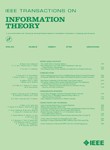Paper published in IEEE Transactions on Information Theory

The paper "Constrained Riemannian Noncoherent Constellations for the MIMO Multiple Access Channel", co-authored by Javier Alvarez-Vizoso, Diego Cuevas, Carlos Beltran, Ignacio Santamaria, Vit Tucek, and Gunnar Peters has been published in IEEE Transactions on Information Theory, DOI:10.1109/TIT.2023.3249903.
Abstract.- We consider the design of multiuser constellations for a multiple access channel (MAC) with $K$ users, with M antennas each, that transmit simultaneously to a receiver equipped with N antennas through a Rayleigh block-fading channel, when no channel state information (CSI) is available to either the transmitter or the receiver. In full-diversity scenarios where the coherence time is at least T >= (K+1)M, the proposed constellation design criterion is based on the asymptotic expression of the multiuser pairwise error probability (PEP) derived by Brehler and Varanasi (2001). In non-full diversity scenarios, for which the previous PEP expression is no longer valid, the proposed design criteria are based on proxies of the PEP recently proposed by Ngo and Yang (2021). Although both the PEP expression and its bounds or proxies were previously considered intractable for optimization, in this work we derive their respective unconstrained gradients. These gradients are in turn used in the optimization of the proposed cost functions in different Riemannian manifolds representing different power constraints. In particular, in addition to the standard unitary space-time modulation (USTM) leading to optimization on the Grassmann manifold, we consider a more relaxed per-codeword power constraint leading to optimization on the so-called oblique manifold, and an average power constraint leading to optimization on the so-called trace manifold. Equipped with these theoretical tools, we design multiuser constellations for the MIMO MAC in full-diversity and non-full-diversity scenarios with state-of-the-art performance in terms of symbol error rate (SER).

